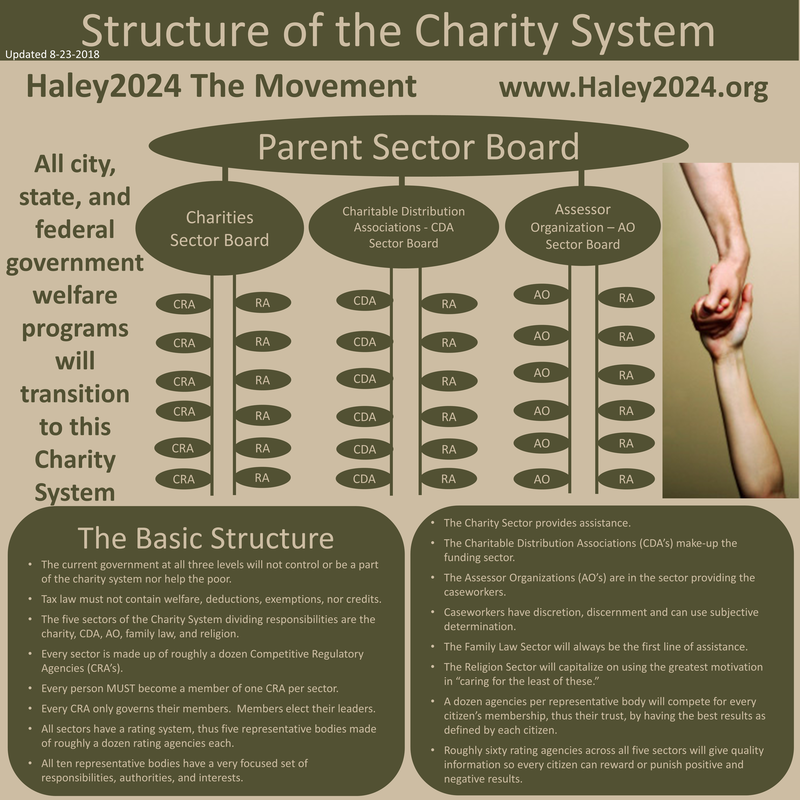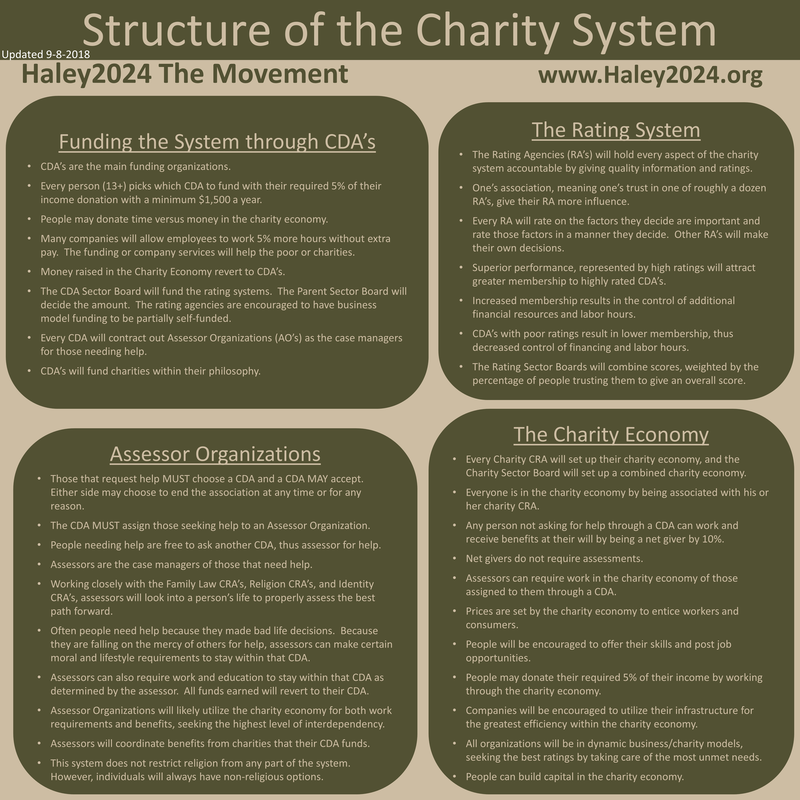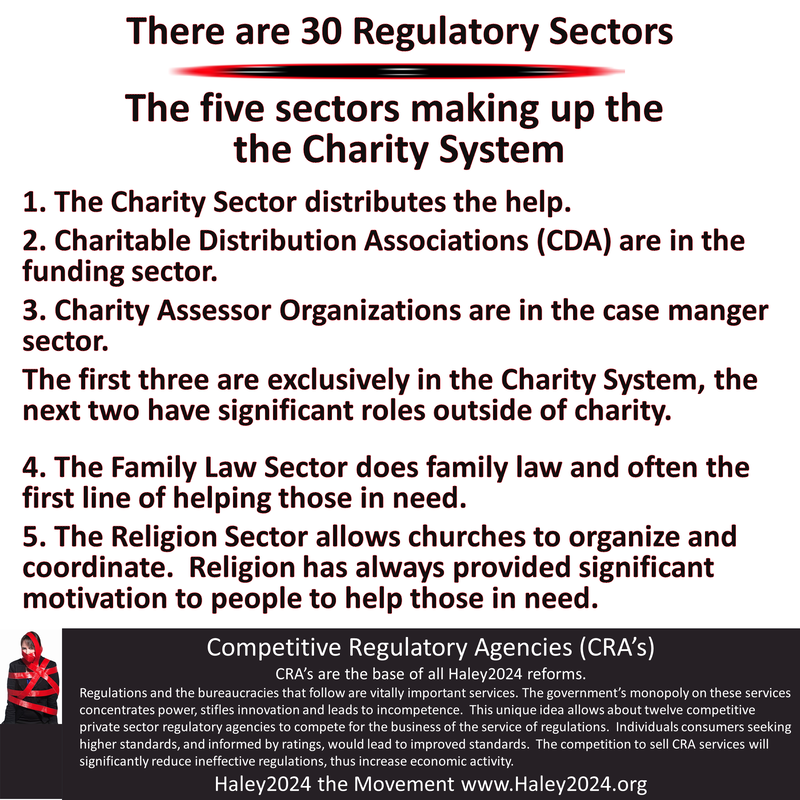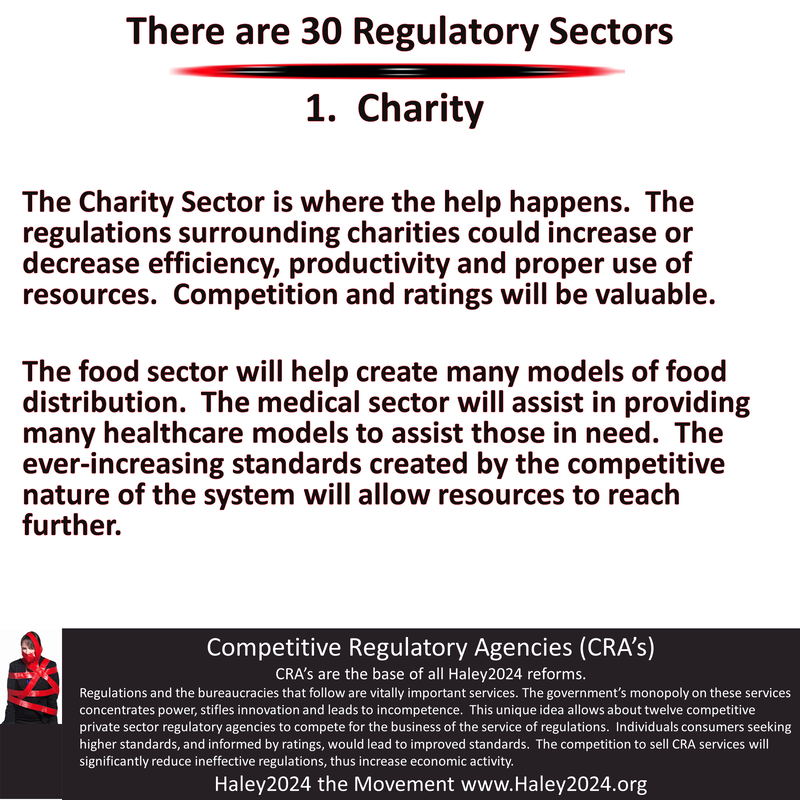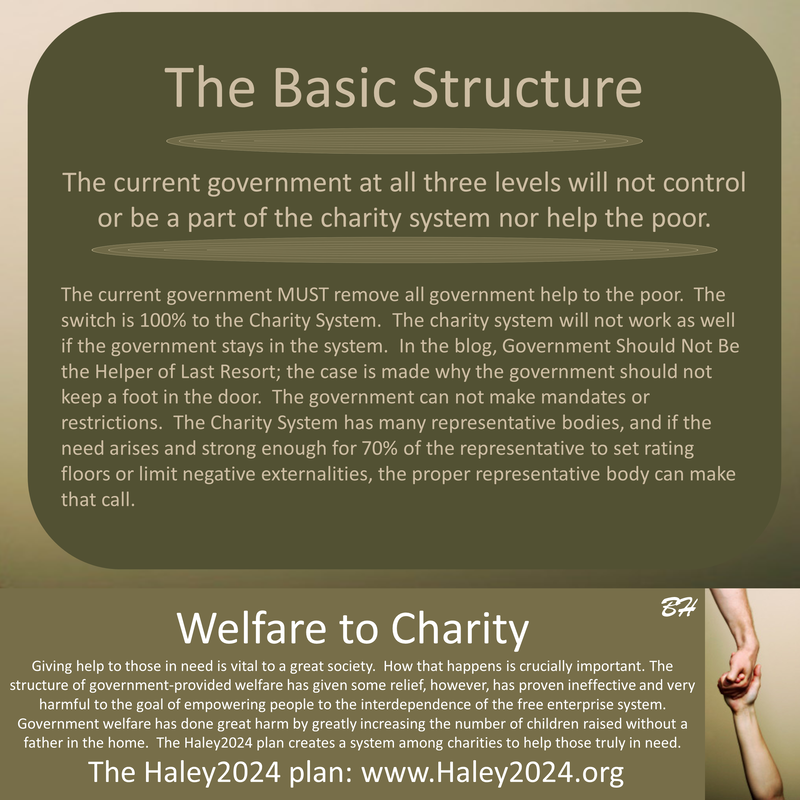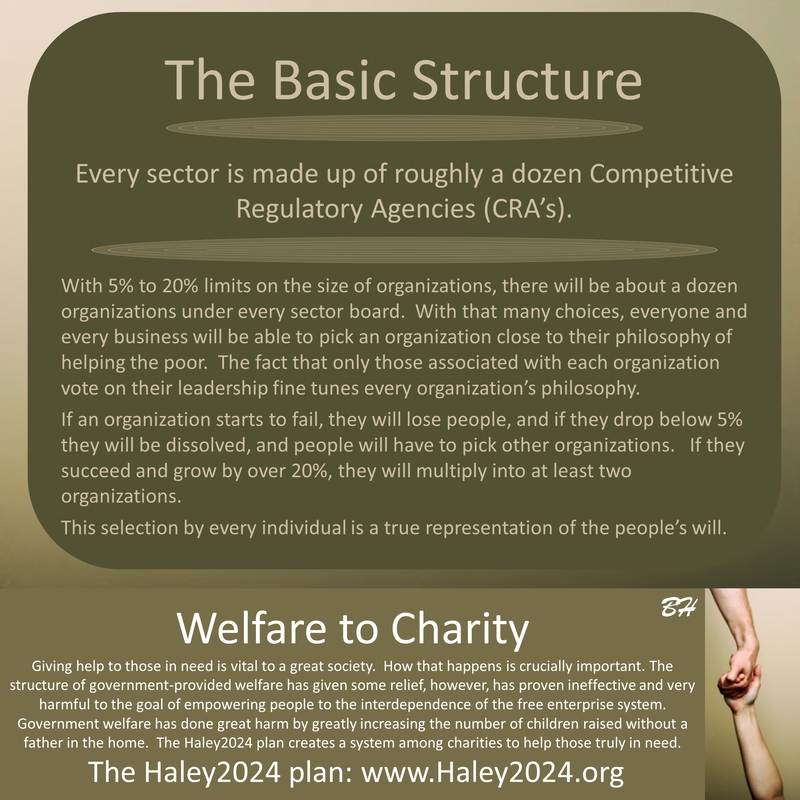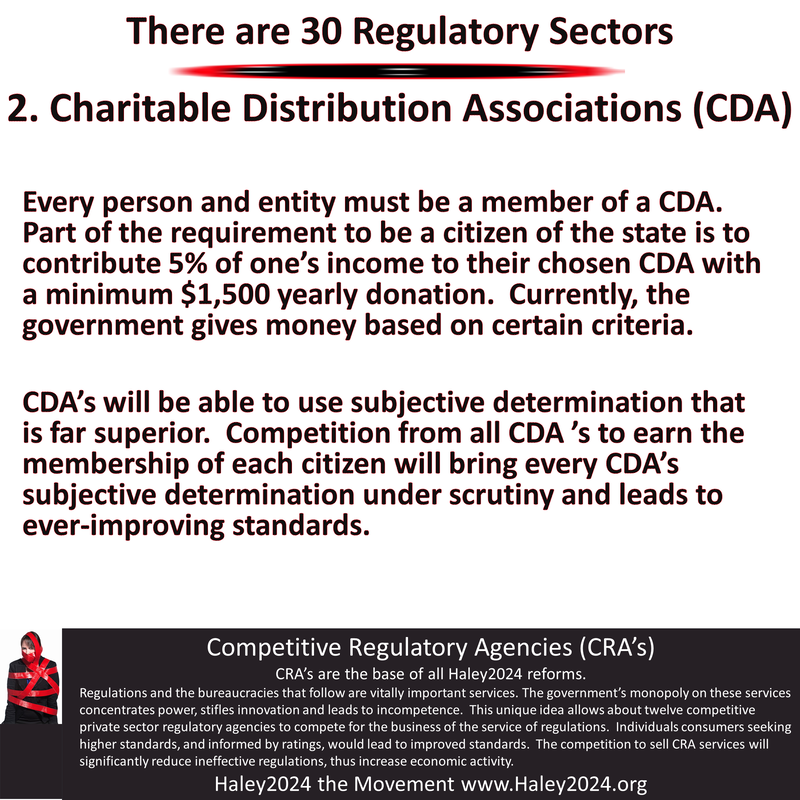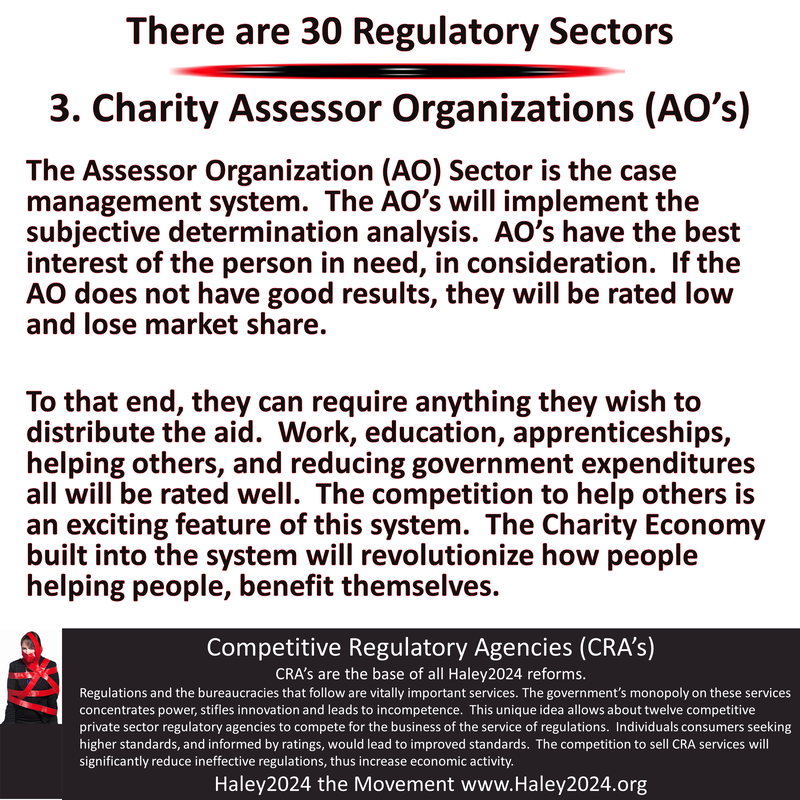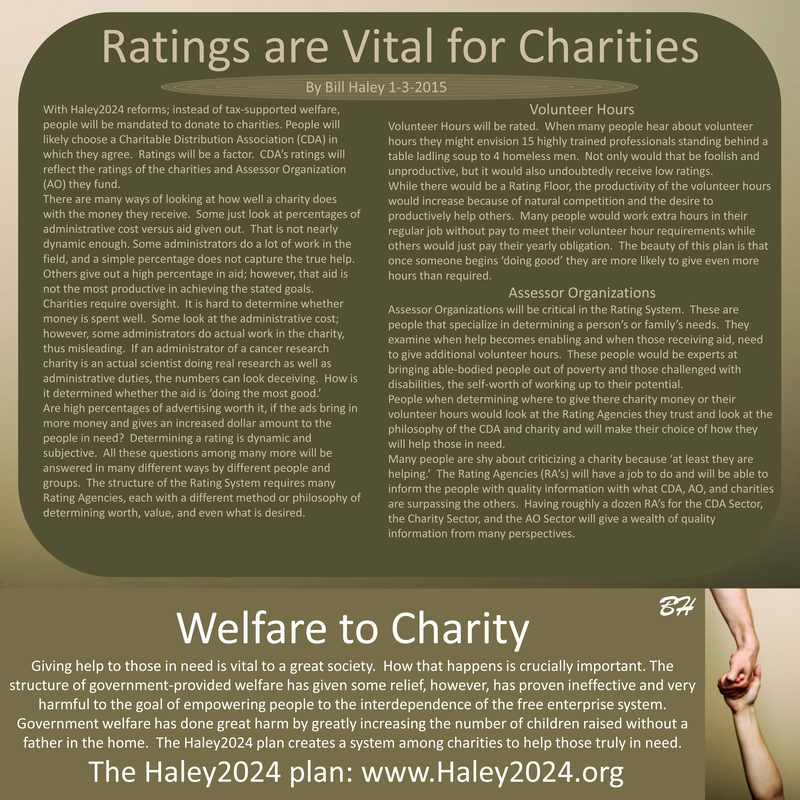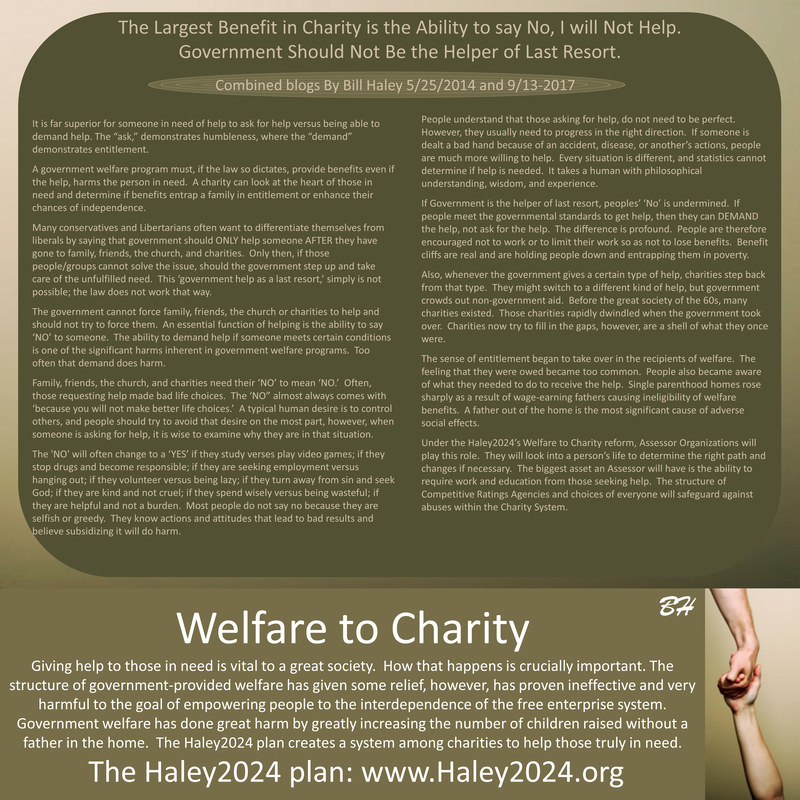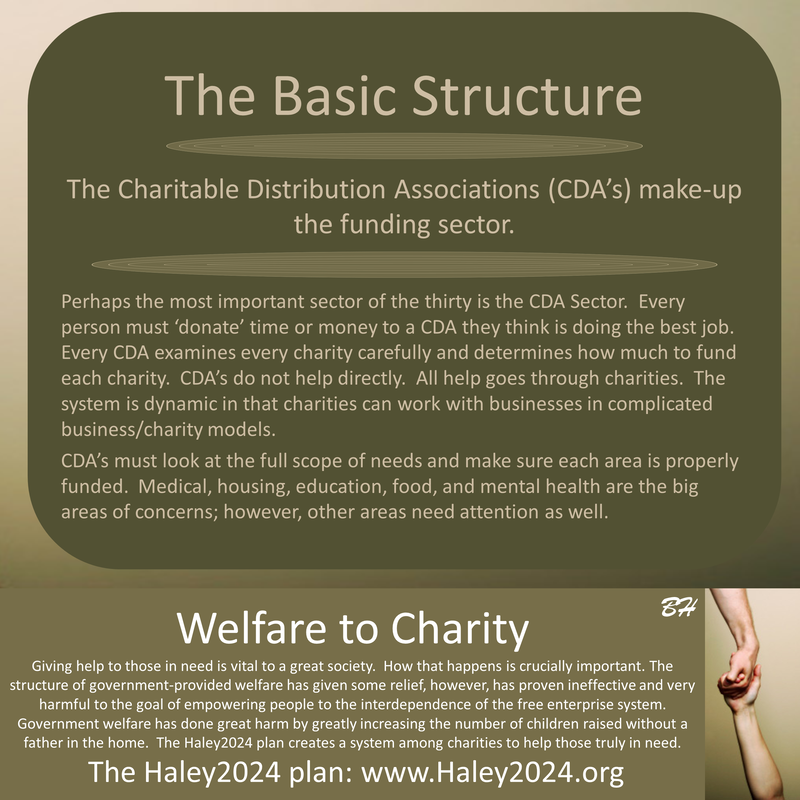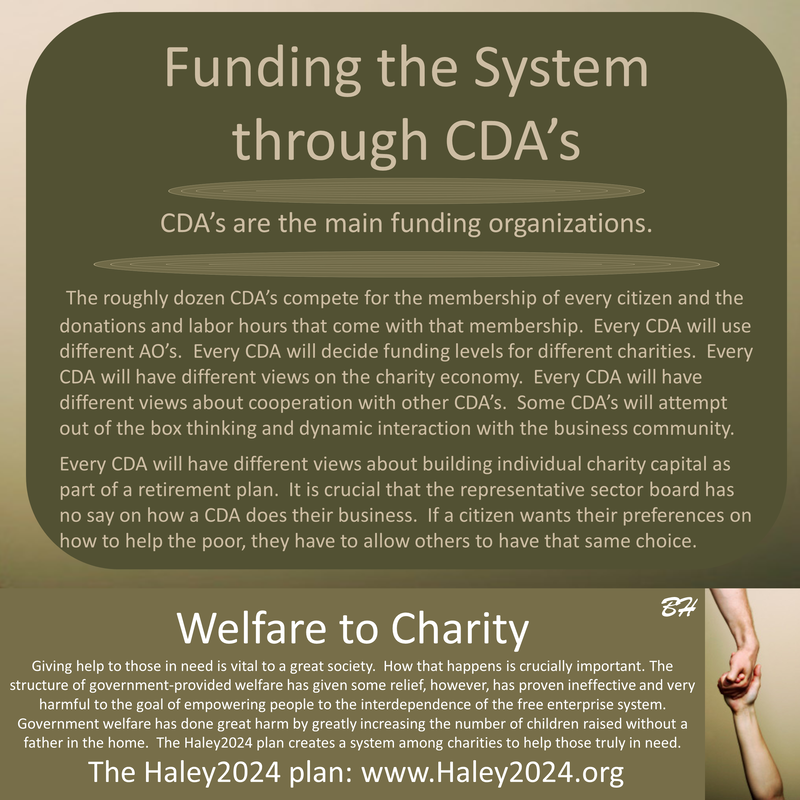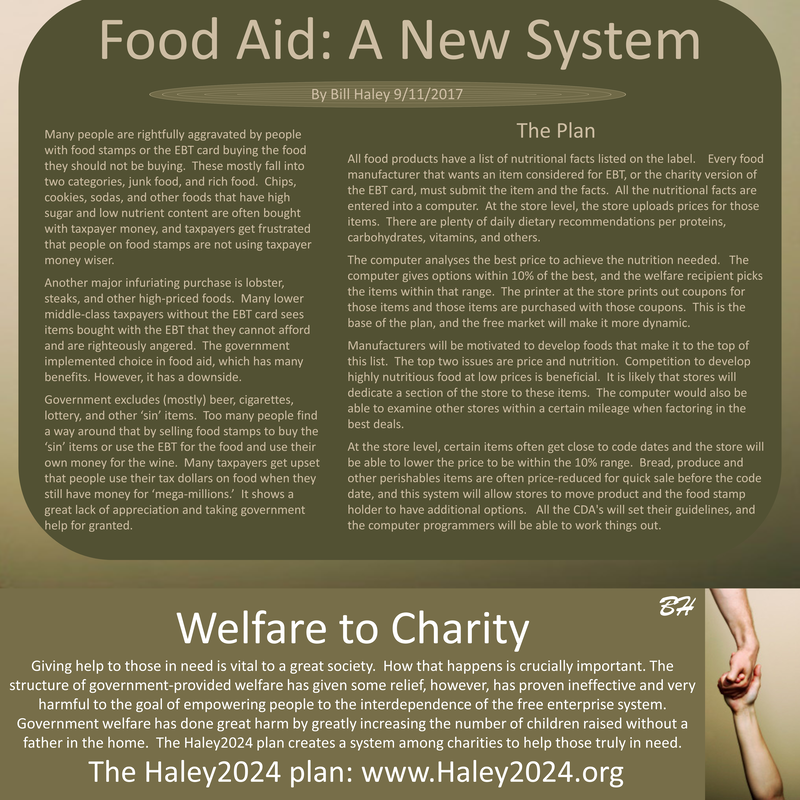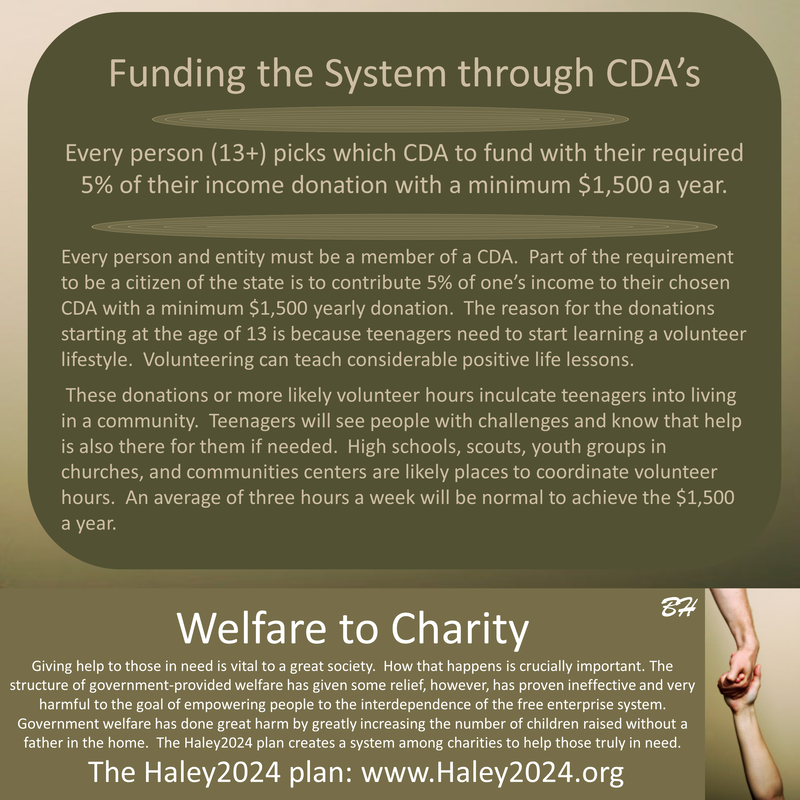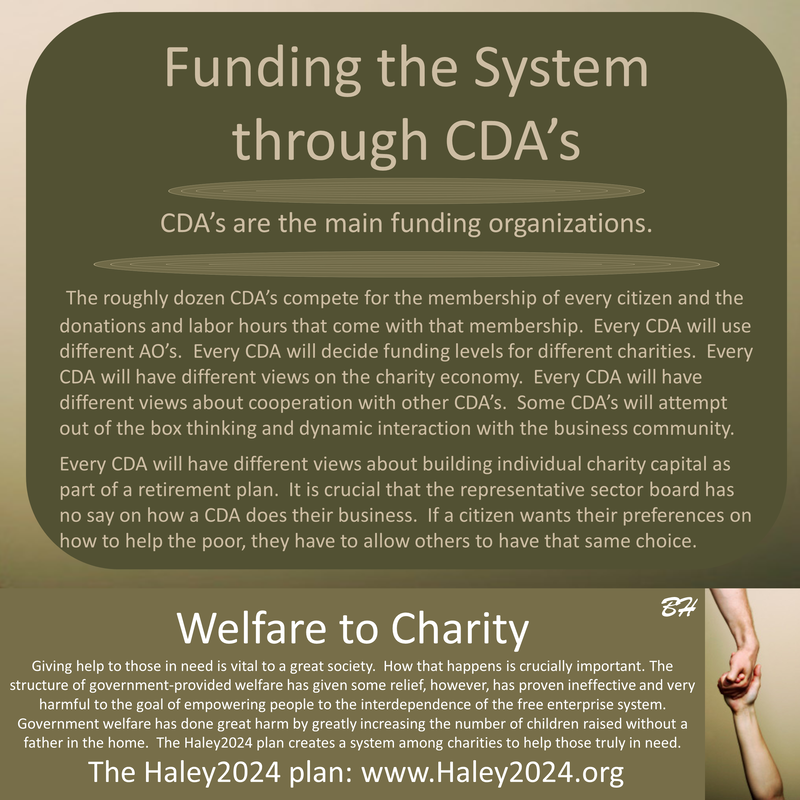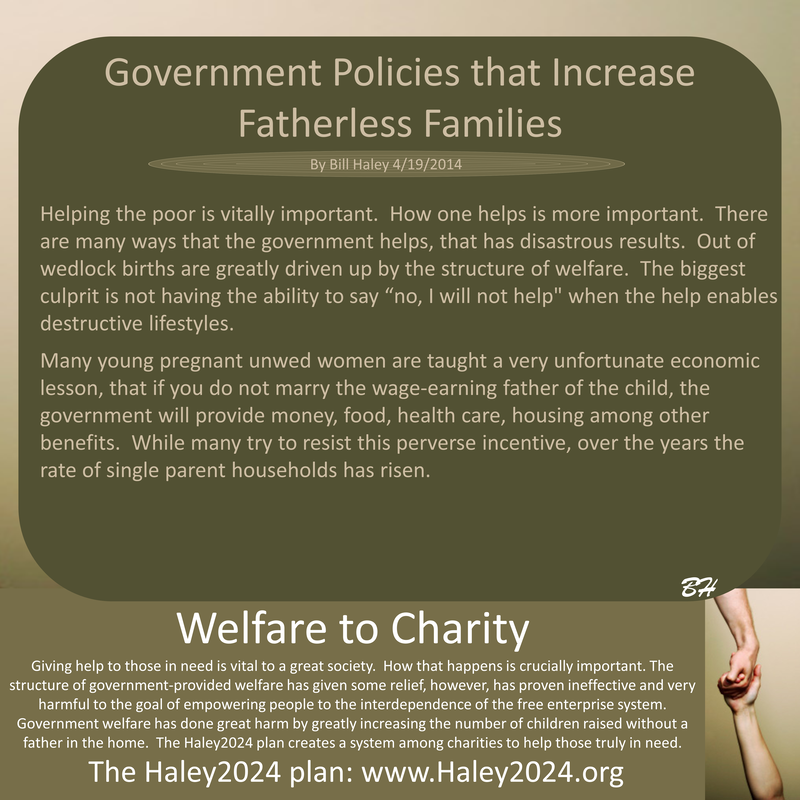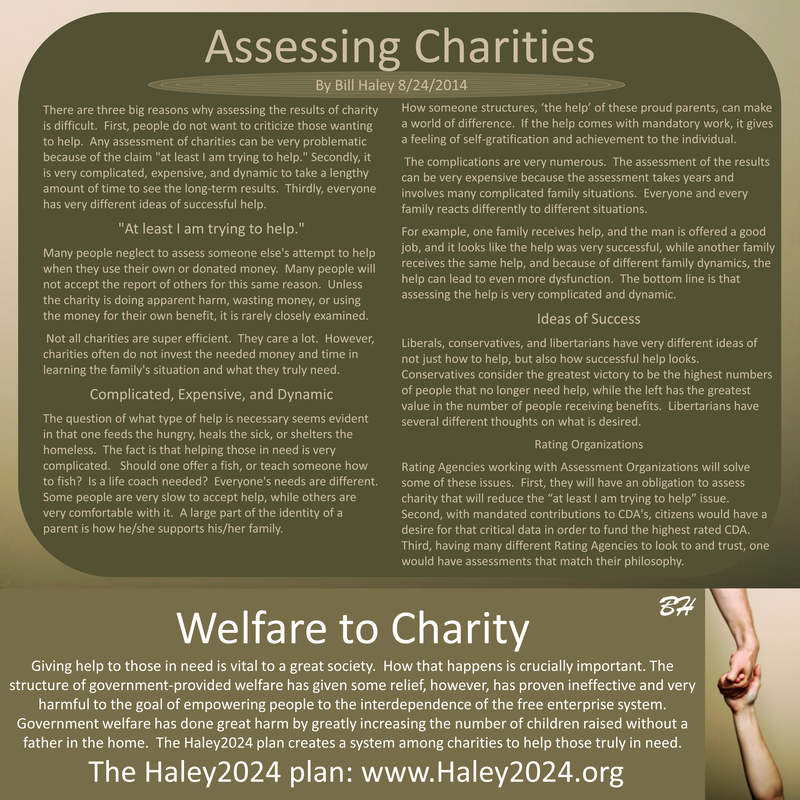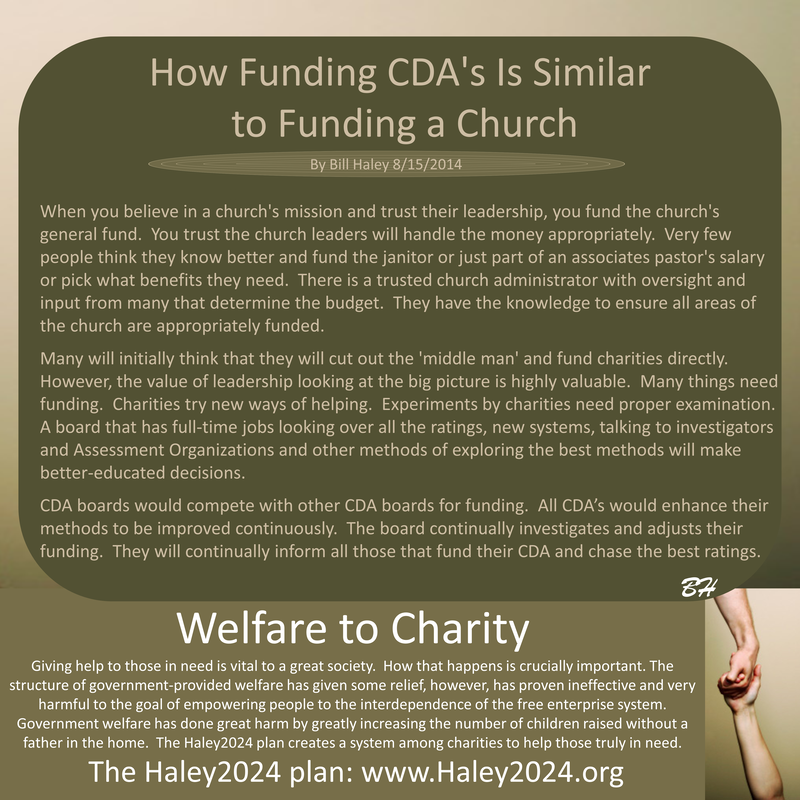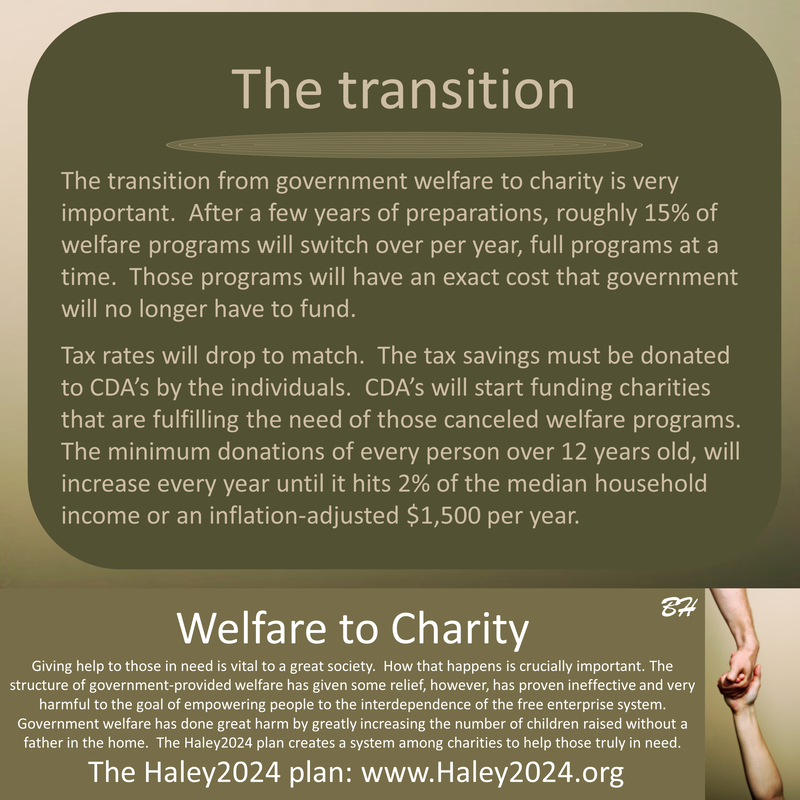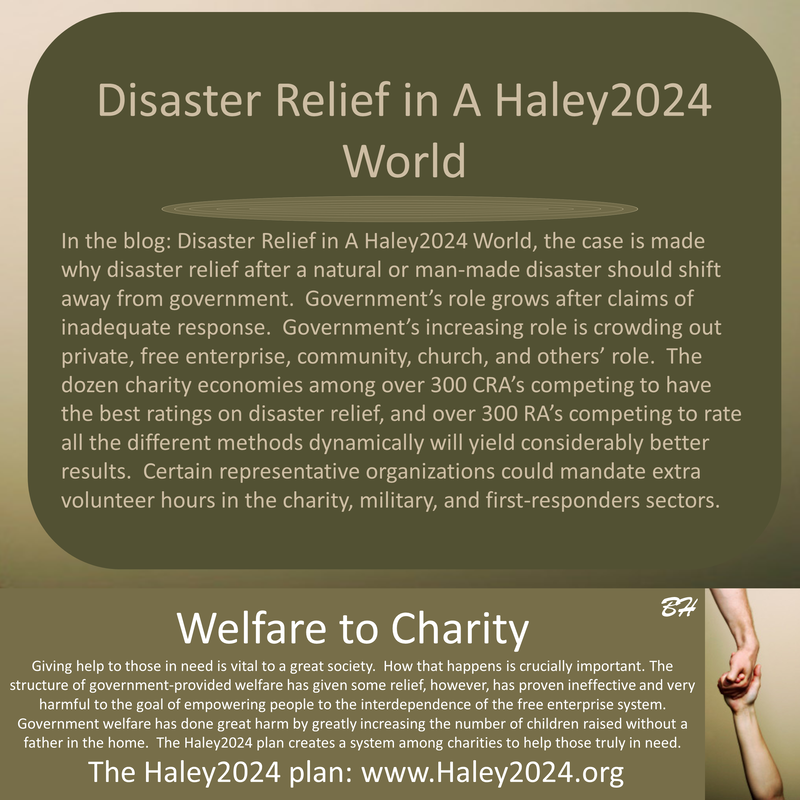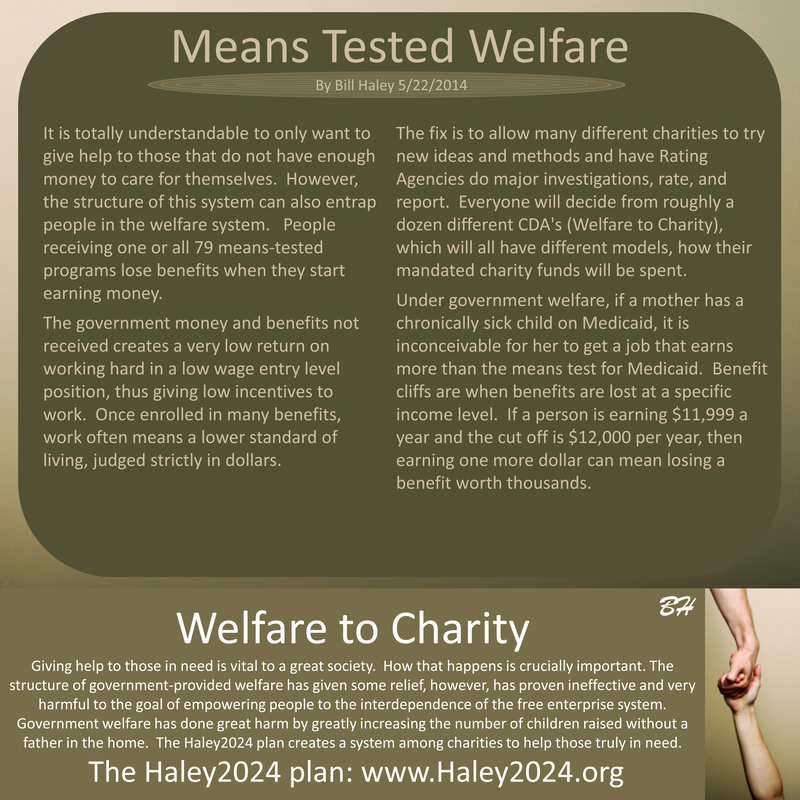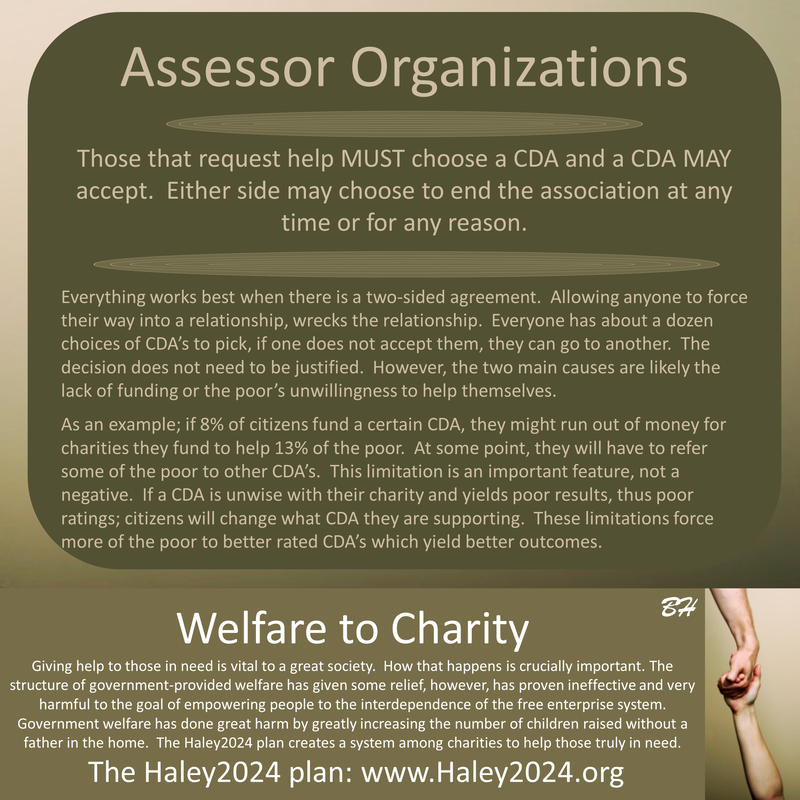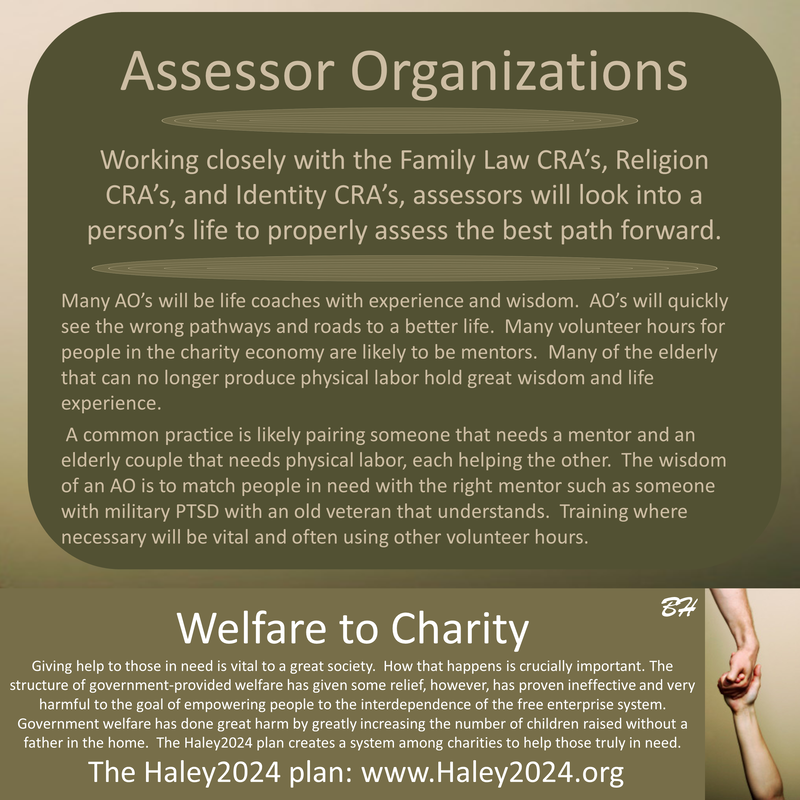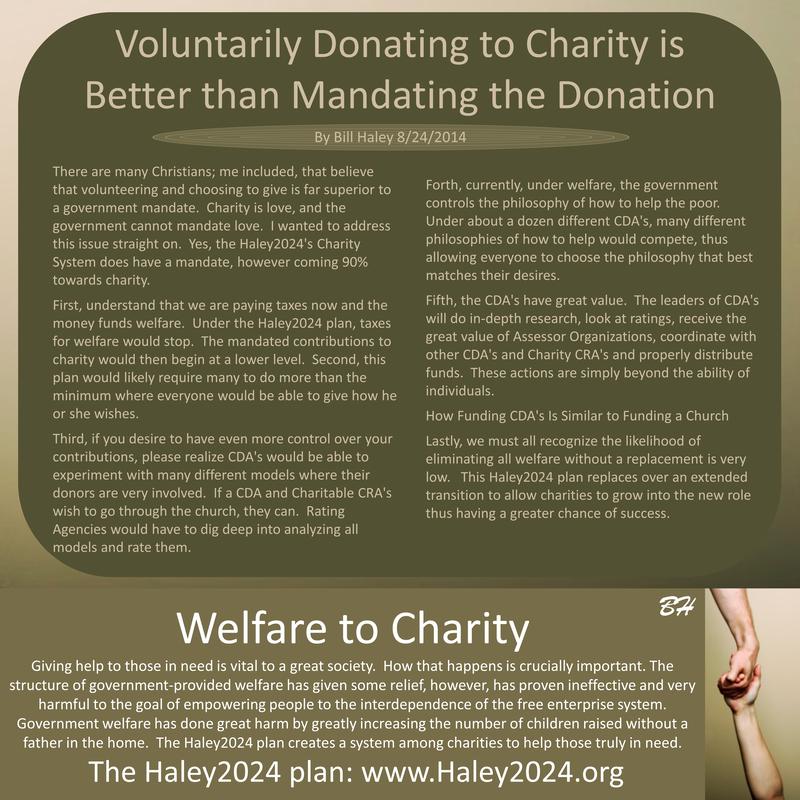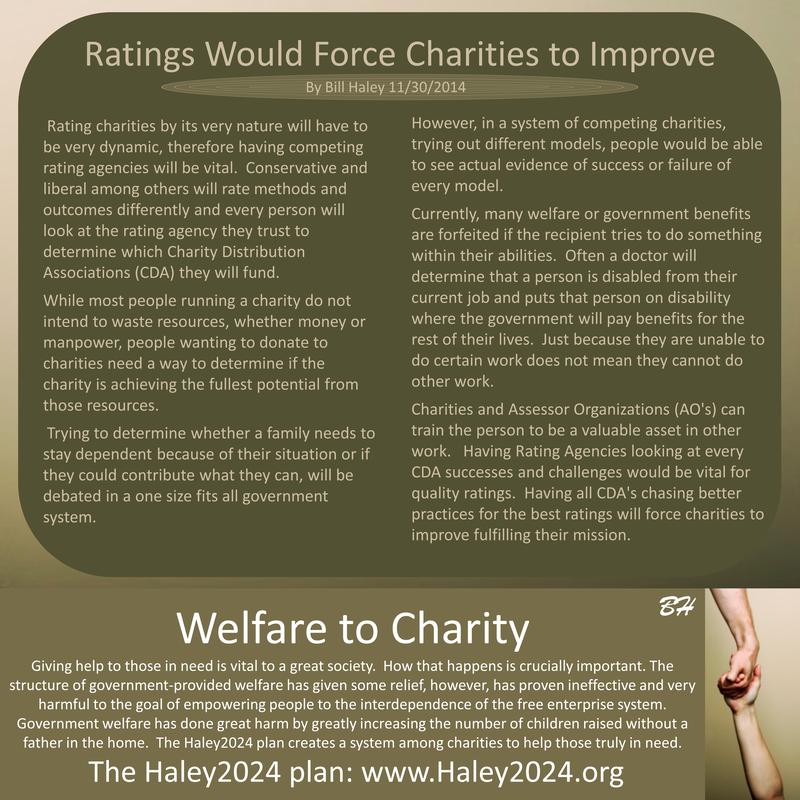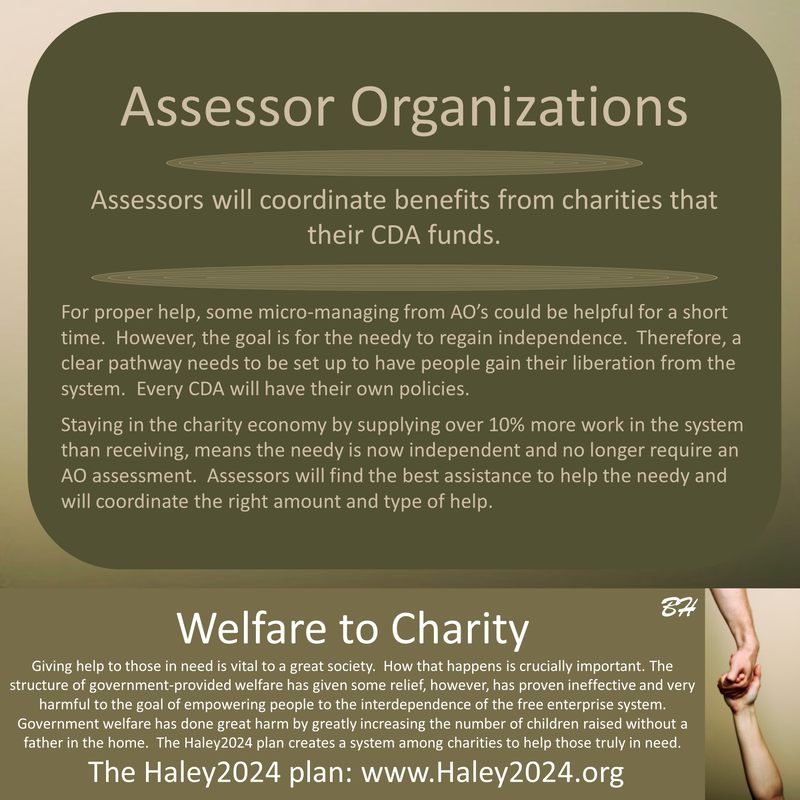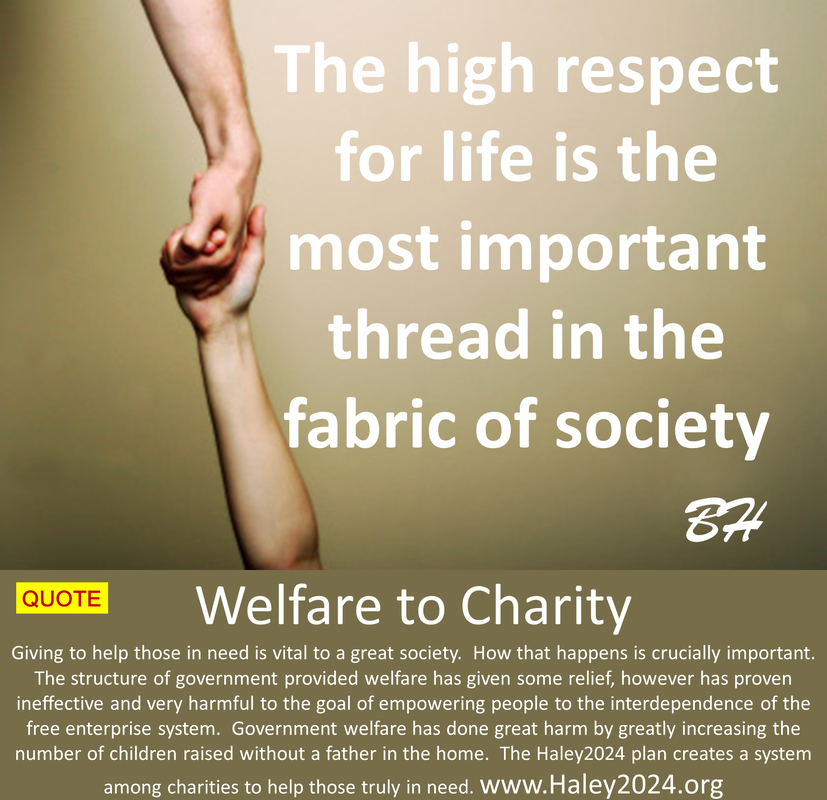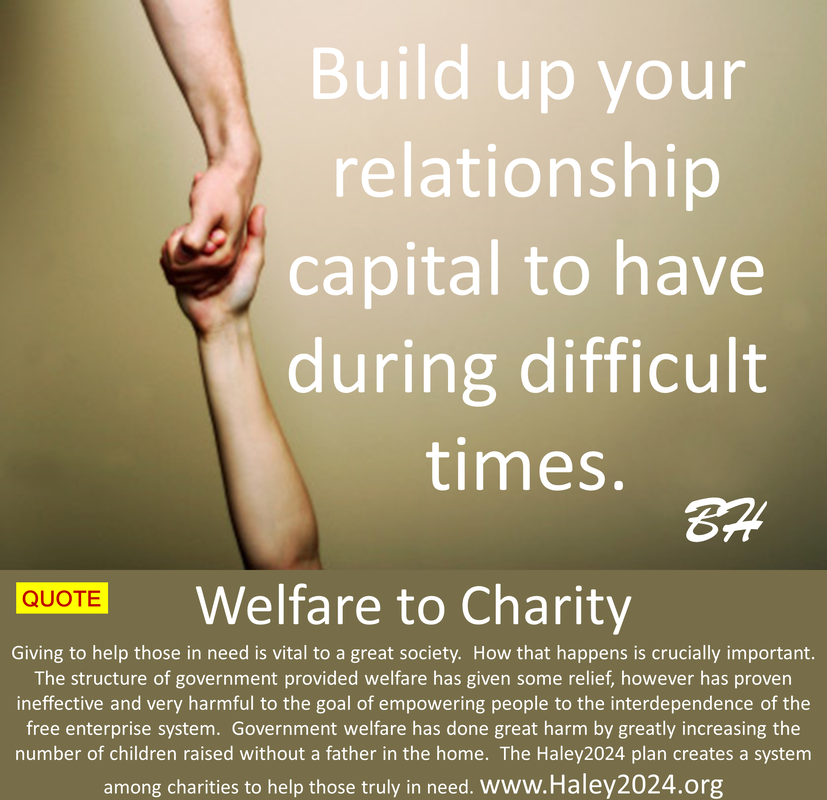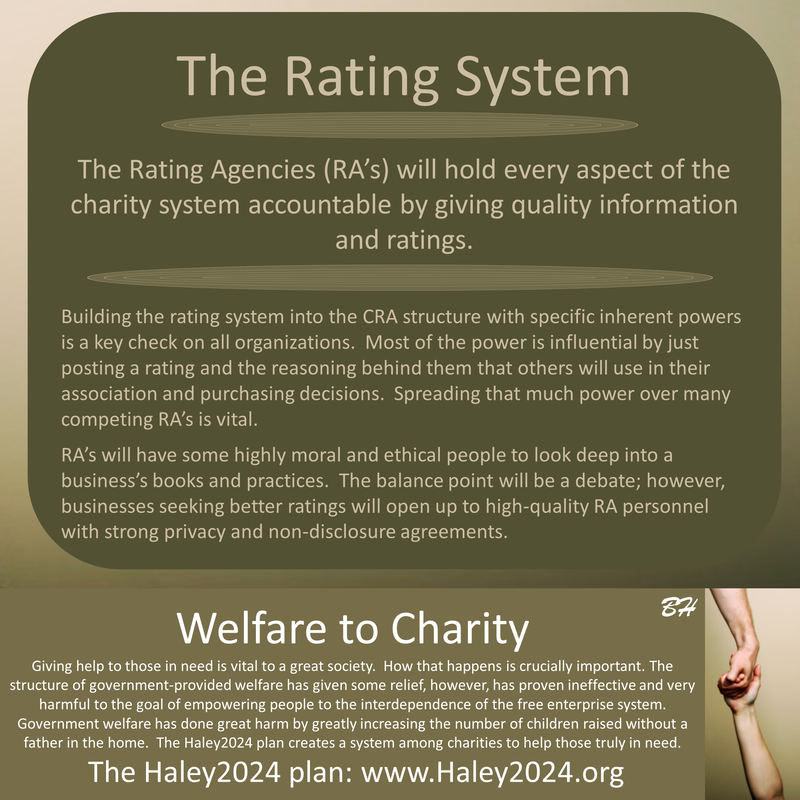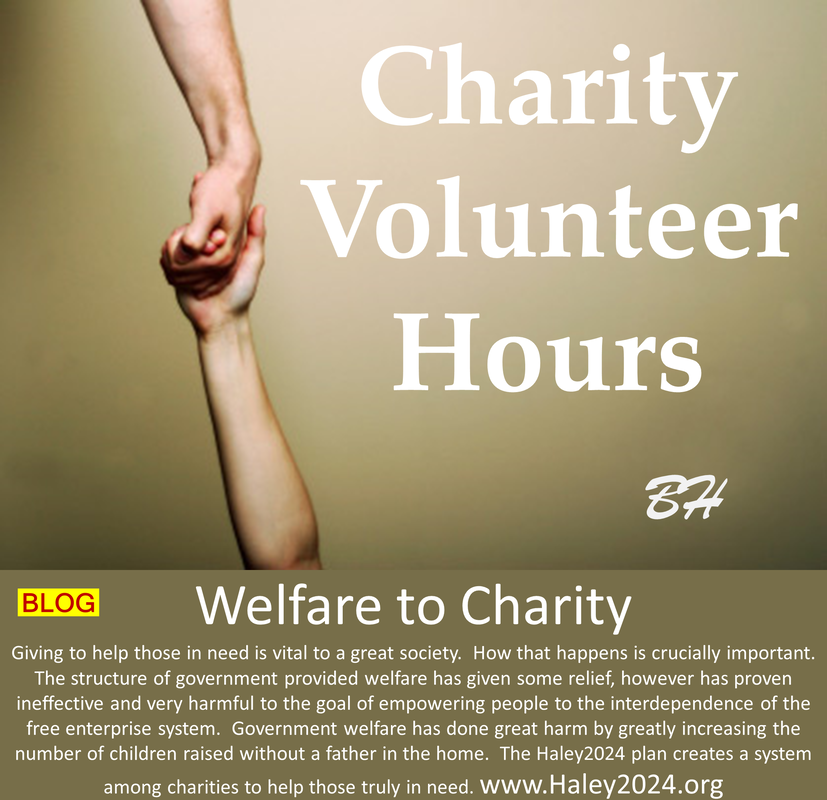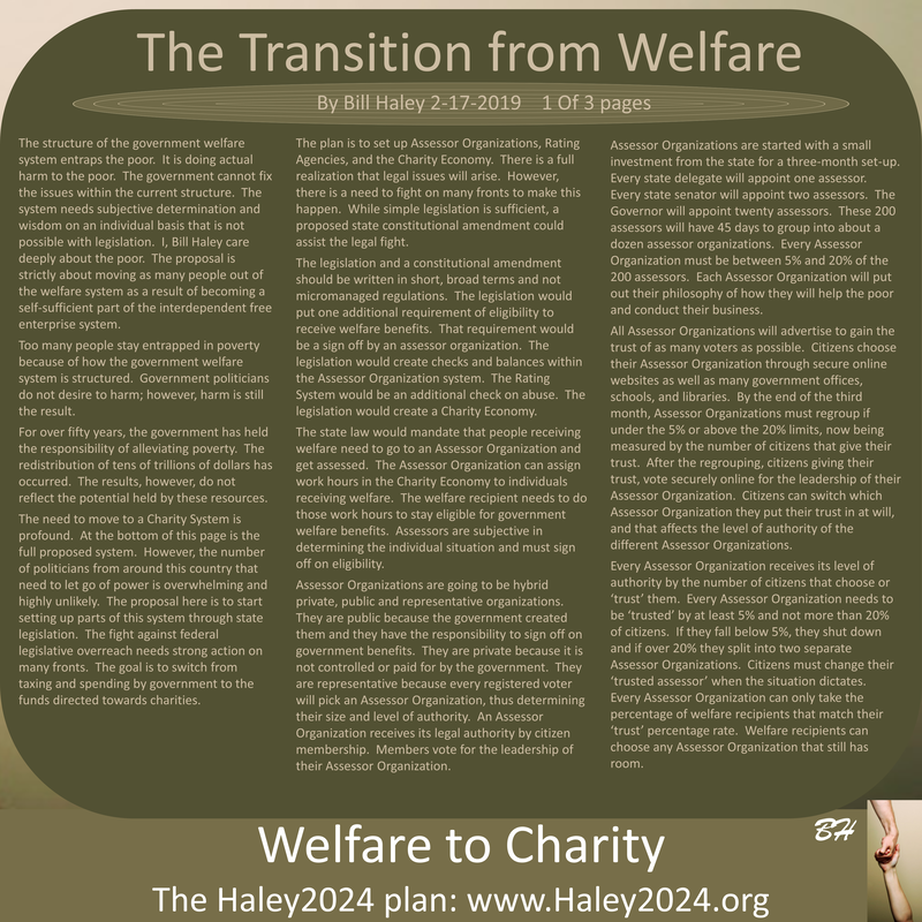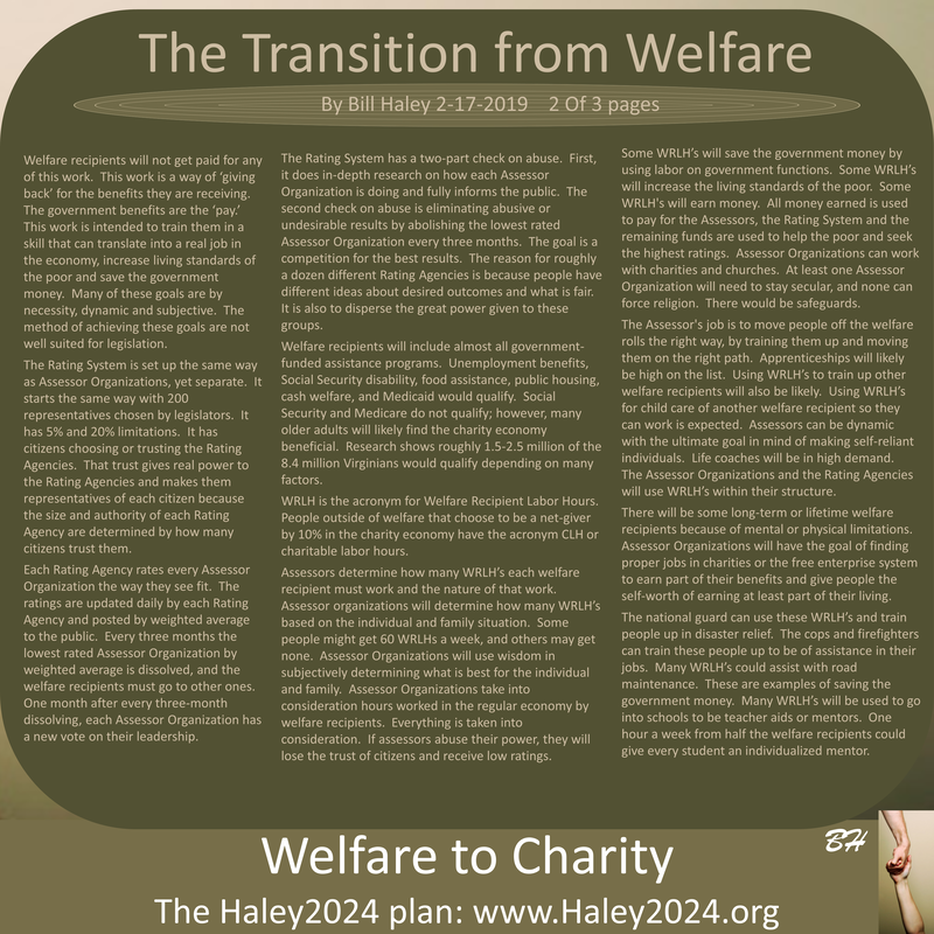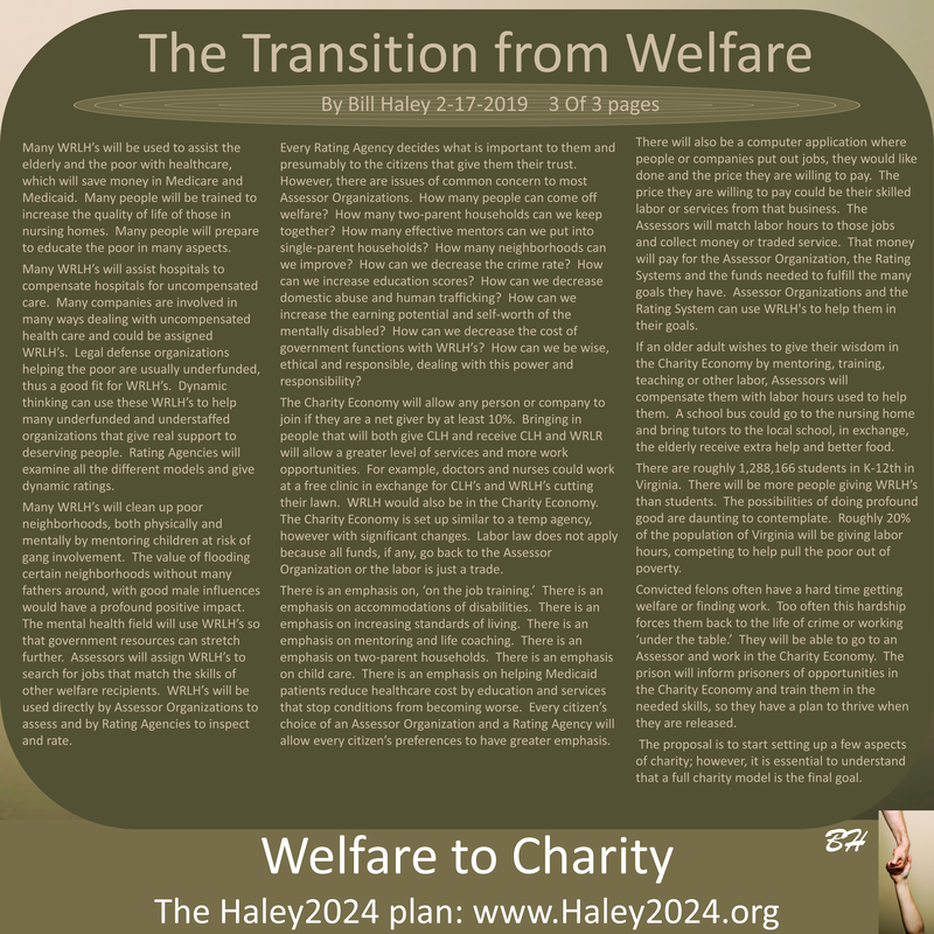| The structure of the government welfare system entraps the poor. It is doing actual harm to the poor. The government can not fix the issues within the current structure. The system needs subjective determination and wisdom on an individual basis that is not possible with legislation. I, Bill Haley care deeply about the poor. The proposal is strictly about moving as many people out of the welfare system as a result of becoming a self-sufficient part of the interdependent free enterprise system. |
| Too many people stay entrapped in poverty because of how the government welfare system is structured. Government politicians do not desire to harm; however, harm is still the result. For over fifty years, the government has held the responsibility of alleviating poverty. The redistribution of tens of trillions of dollars has occurred. The results, however, do not reflect the potential held by these resources. |
| The need to move to a Charity System is profound. At the bottom of this page is the full proposed system. However, the number of politicians from around this country that need to let go of power is overwhelming and highly unlikely. The proposal here is to start setting up parts of this system through state legislation. The fight against federal legislative overreach needs strong action on many fronts. The goal is to switch from taxing and spending by government to the funds directed towards charities. |
| The plan is to set up Assessor Organizations, Rating Agencies, and the Charity Economy. There is a full realization that legal issues will arise. However, there is a need to fight on many fronts to make this happen. While simple legislation is sufficient, a proposed state constitutional amendment could assist the legal fight. |
| The legislation and a constitutional amendment should be written in short, broad terms and not micromanaged regulations. The legislation would put one additional requirement of eligibility to receive welfare benefits. That requirement would be a sign off by an assessor organization. The legislation would create checks and balances within the Assessor Organization system. The Rating System would be an additional check on abuse. The legislation would create a Charity Economy. |
| The state law would mandate that people receiving welfare need to go to an Assessor Organization and get assessed. The Assessor Organization can assign work hours in the Charity Economy to individuals receiving welfare. The welfare recipient needs to do those work hours to stay eligible for government welfare benefits. Assessors are subjective in determining the individual situation and must sign off on eligibility. |
| Assessor Organizations are going to be hybrid private, public and representative organizations. They are public because the government created them and they have the responsibility to sign off on government benefits. They are private because it is not controlled or paid for by the government. They are representative because every registered voter will pick an Assessor Organization, thus determining their size and level of authority. An Assessor Organization receives its legal authority by citizen membership. Members vote for the leadership of their Assessor Organization. |
| Assessor Organizations are started with a small investment from the state for a three-month set-up. Every state delegate will appoint one assessor. Every state senator will appoint two assessors. The Governor will appoint twenty assessors. These 200 assessors will have 45 days to group into about a dozen assessor organizations. Every Assessor Organization must be between 5% and 20% of the 200 assessors. Each Assessor Organization will put out their philosophy of how they will help the poor and conduct their business. |
| All Assessor Organizations will advertise to gain the trust of as many voters as possible. Citizens choose their Assessor Organization through secure online websites as well as many government offices, schools, and libraries. By the end of the third month, Assessor Organizations must regroup if under the 5% or above the 20% limits, now being measured by the number of citizens that give their trust. After the regrouping, citizens giving their trust, vote securely online for the leadership of their Assessor Organization. Citizens can switch which Assessor Organization they put their trust in at will, and that affects the level of authority of the different Assessor Organizations. |
| Every Assessor Organization receives its level of authority by the number of citizens that choose or ‘trust’ them. Every Assessor Organization needs to be ‘trusted’ by at least 5% and not more than 20% of citizens. If they fall below 5%, they shut down and if over 20% they split into two separate Assessor Organizations. Citizens must change their ‘trusted assessor’ when the situation dictates. Every Assessor Organization can only take the percentage of welfare recipients that match their ‘trust’ percentage rate. Welfare recipients can choose any Assessor Organization that still has room. |
| Welfare recipients will not get paid for any of this work. This work is a way of ‘giving back’ for the benefits they are receiving. The government benefits are the ‘pay.’ This work is intended to train them in a skill that can translate into a real job in the economy, increase living standards of the poor and save the government money. Many of these goals are by necessity, dynamic and subjective. The method of achieving these goals are not well suited for legislation. |
| The Rating System is set up the same way as Assessor Organizations, yet separate. It starts the same way with 200 representatives chosen by legislators. It has 5% and 20% limitations. It has citizens choosing or trusting the Rating Agencies. That trust gives real power to the Rating Agencies and makes them representatives of each citizen because the size and authority of each Rating Agency are determined by how many citizens trust them. |
| Each Rating Agency rates every Assessor Organization the way they see fit. The ratings are updated daily by each Rating Agency and posted by weighted average to the public. Every three months the lowest rated Assessor Organization by weighted average is dissolved, and the welfare recipients must go to other ones. One month after every three-month dissolving, each Assessor Organization has a new vote on their leadership. |
| The Rating System has a two-part check on abuse. First, it does in-depth research on how each Assessor Organization is doing and fully informs the public. The second check on abuse is eliminating abusive or undesirable results by abolishing the lowest rated Assessor Organization every three months. The goal is a competition for the best results. The reason for roughly a dozen different Rating Agencies is because people have different ideas about desired outcomes and what is fair. It is also to disperse the great power given to these groups. |
| Welfare recipients will include almost all government-funded assistance programs. Unemployment benefits, Social Security disability, food assistance, public housing, cash welfare, and Medicaid would qualify. Social Security and Medicare do not qualify; however, many older adults will likely find the charity economy beneficial. Research shows roughly 1.5-2.5 million of the 8.4 million Virginians would qualify depending on many factors. WRLH is the acronym for Welfare Recipient Labor Hours. People outside of welfare that choose to be a net-giver by 10% in the charity economy have the acronym CLH or charitable labor hours. |
| Assessors determine how many WRLH’s each welfare recipient must work and the nature of that work. Assessor organizations will determine how many WRLH’s based on the individual and family situation. Some people might get 60 WRLHs a week, and others may get none. Assessor Organizations will use wisdom in subjectively determining what is best for the individual and family. Assessor Organizations take into consideration hours worked in the regular economy by welfare recipients. Everything is taken into consideration. If assessors abuse their power, they will lose the trust of citizens and receive low ratings. |
| Some WRLH’s will save the government money by using labor on government functions. Some WRLH’s will increase the living standards of the poor. Some WRLH's will earn money. All money earned is used to pay for the Assessors, the Rating System and the remaining funds are used to help the poor and seek the highest ratings. Assessor Organizations can work with charities and churches. At least one Assessor Organization will need to stay secular, and none can force religion. There would be safeguards. |
| The Assessor's job is to move people off the welfare rolls the right way, by training them up and moving them on the right path. Apprenticeships will likely be high on the list. Using WRLH’s to train up other welfare recipients will also be likely. Using WRLH’s for child care of another welfare recipient so they can work is expected. Assessors can be dynamic with the ultimate goal in mind of making self-reliant individuals. Life coaches will be in high demand. The Assessor Organizations and the Rating Agencies will use WRLH’s within their structure. |
| There will be some long-term or lifetime welfare recipients because of mental or physical limitations. Assessor Organizations will have the goal of finding proper jobs in charities or the free enterprise system to earn part of their benefits and give people the self-worth of earning at least part of their living. |
| The national guard can use these WRLH’s and train people up in disaster relief. The cops and firefighters can train these people up to be of assistance in their jobs. Many WRLH’s could assist with road maintenance. These are examples of saving the government money. Many WRLH’s will be used to go into schools to be teacher aids or mentors. One hour a week from half the welfare recipients could give every student an individualized mentor. |
| Many WRLH’s will assist hospitals to compensate hospitals for uncompensated care. Many companies are involved in many ways dealing with uncompensated health care and could be assigned WRLH’s. Legal defense organizations helping the poor are usually underfunded, thus a good fit for WRLH’s. Dynamic thinking can use these WRLH’s to help many underfunded and understaffed organizations that give real support to deserving people. Rating Agencies will examine all the different models and give dynamic ratings. |
| Many WRLH’s will clean up poor neighborhoods, both physically and mentally by mentoring children at risk of gang involvement. The value of flooding certain neighborhoods without many fathers around, with good male influences would have a profound positive impact. The mental health field will use WRLH’s so that government resources can stretch further. Assessors will assign WRLH’s to search for jobs that match the skills of other welfare recipients. WRLH’s will be used directly by Assessor Organizations to assess and by Rating Agencies to inspect and rate. |
| Every Rating Agency decides what is important to them and presumably to the citizens that give them their trust. However, there are issues of common concern to most Assessor Organizations. How many people can come off welfare? How many two-parent households can we keep together? How many effective mentors can we put into single-parent households? How many neighborhoods can we improve? How can we decrease the crime rate? How can we increase education scores? How can we decrease domestic abuse and human trafficking? How can we increase the earning potential and self-worth of the mentally disabled? How can we decrease the cost of government functions with WRLH’s? How can we be wise, ethical and responsible, dealing with this power and responsibility? |
| The Charity Economy will allow any person or company to join if they are a net giver by at least 10%. Bringing in people that will both give CLH and receive CLH and WRLR will allow a greater level of services and more work opportunities. For example, doctors and nurses could work at a free clinic in exchange for CLH’s and WRLH’s cutting their lawn. WRLH would also be in the Charity Economy. The Charity Economy is set up similar to a temp agency, however with significant changes. Labor law does not apply because all funds, if any, go back to the Assessor Organization or the labor is just a trade. |
| There is an emphasis on, ‘on the job training.’ There is an emphasis on accommodations of disabilities. There is an emphasis on increasing standards of living. There is an emphasis on mentoring and life coaching. There is an emphasis on two-parent households. There is an emphasis on child care. There is an emphasis on helping Medicaid patients reduce healthcare cost by education and services that stop conditions from becoming worse. Every citizen’s choice of an Assessor Organization and a Rating Agency will allow every citizen’s preferences to have greater emphasis. |
| There will also be a computer application where people or companies put out jobs, they would like done and the price they are willing to pay. The price they are willing to pay could be their skilled labor or services from that business. The Assessors will match labor hours to those jobs and collect money or traded service. That money will pay for the Assessor Organization, the Rating Systems and the funds needed to fulfill the many goals they have. Assessor Organizations and the Rating System can use WRLH's to help them in their goals. |
| If an older adult wishes to give their wisdom in the Charity Economy by mentoring, training, teaching or other labor, Assessors will compensate them with labor hours used to help them. A school bus could go to the nursing home and bring tutors to the local school, in exchange, the elderly receive extra help and better food. |
| There are roughly 1,288,166 students in K-12th in Virginia. There will be more people giving WRLH’s than students. The possibilities of doing profound good are daunting to contemplate. Roughly 20% of the population of Virginia will be giving labor hours, competing to help pull the poor out of poverty. |
| Convicted felons often have a hard time getting welfare or finding work. Too often this hardship forces them back to the life of crime or working ‘under the table.’ They will be able to go to an Assessor and work in the Charity Economy. The prison will inform prisoners of opportunities in the Charity Economy and train them in the needed skills, so they have a plan to thrive when they are released. The proposal is to start setting up a few aspects of charity; however, it is essential to understand that a full charity model is the final goal. |
